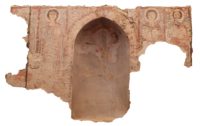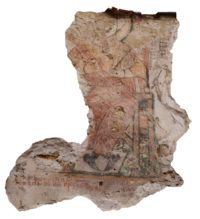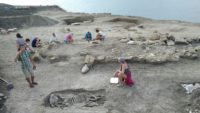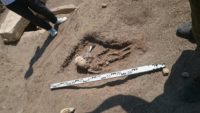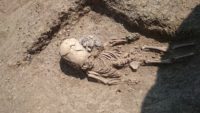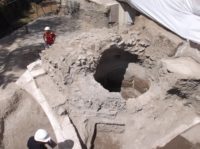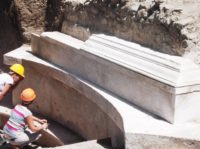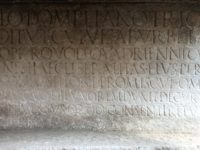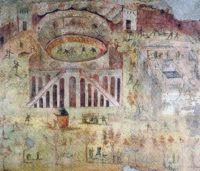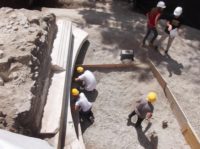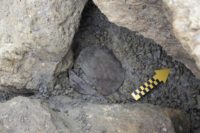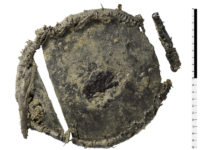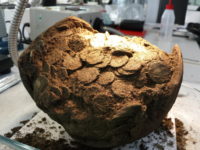 A hoard of 1,608 coins Roman coins discovered by metal detectorists in a field it Boldre, in the New Forest near Lymington, Hampshire, in 2014, has gone on public display for the first time at the St Barbe Museum and Art Gallery in Lymington. The hoard dates to the 3rd century A.D. and contains bronze radiates from the second half of the 3rd century. The earliest coin in the group was minted under the reign of Trebonianus Gallus (249-51 A.D.). The most recent is barely 25 years older, struck in 276 in the waning days of the emperor Tacitus (275-6 A.D.). The bulk of the coins were found in the remains of a round vessel, 15 sherds from the bottom of the earthenware pot.
A hoard of 1,608 coins Roman coins discovered by metal detectorists in a field it Boldre, in the New Forest near Lymington, Hampshire, in 2014, has gone on public display for the first time at the St Barbe Museum and Art Gallery in Lymington. The hoard dates to the 3rd century A.D. and contains bronze radiates from the second half of the 3rd century. The earliest coin in the group was minted under the reign of Trebonianus Gallus (249-51 A.D.). The most recent is barely 25 years older, struck in 276 in the waning days of the emperor Tacitus (275-6 A.D.). The bulk of the coins were found in the remains of a round vessel, 15 sherds from the bottom of the earthenware pot.
After slumbering underground for more than 1,700 years since its owner buried his savings, disturbed only by the farm equipment that likely broke the pot, the hoard has seen quite a bit of drama starting with the moment of its discovery. There were several metal detectorists scanning that field in Boldre on May 4th, 2014, among them two old friends Andy Aartsen and James Petts. Aartsen made the first discovery: 25-30 coins on their own. Then Petts hit the motherlode, finding the remains of the pot and its coin hoard of more than 1,500 pieces.
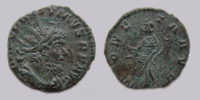 Aartsen had scanned that area earlier and gotten a signal but had moved on. According to the rules of the metal detecting club, if you walk away from a signal it counts as abandonment and the next guy gets to pick up where you left off, but Aartsen apparently thought his earlier signal granted him perpetual rights because he told Petts “Eff off, it’s mine.” That’s a quote from James Petts’ testimony at the coroner’s inquest that determined whether the coin hoard was official treasure by the standards of the Treasure Act of 1996, which is downright spicy compared to the usual testimony from British Museum and Portable Antiquities Scheme experts one encounters at treasure inquests.
Aartsen had scanned that area earlier and gotten a signal but had moved on. According to the rules of the metal detecting club, if you walk away from a signal it counts as abandonment and the next guy gets to pick up where you left off, but Aartsen apparently thought his earlier signal granted him perpetual rights because he told Petts “Eff off, it’s mine.” That’s a quote from James Petts’ testimony at the coroner’s inquest that determined whether the coin hoard was official treasure by the standards of the Treasure Act of 1996, which is downright spicy compared to the usual testimony from British Museum and Portable Antiquities Scheme experts one encounters at treasure inquests.
The conflict caused a permanent rift between the former friends, and it really wasn’t about the money because bronze radiates aren’t big ticket items. The amount of the valuation that would be paid by the museum that acquired the hoard was around £8,000 to be split 50/50 by the finder and landowner. This fight was all about credit, who gets to be the official finder of the Boldre Hoard. Andy Aartsen wanted to be declared the sole finder; Petts wanted it declared a joint find of both men, which seems more than fair given that he found the vast majority of the hoard and the container. At the time of the inquest, the dispute was still ongoing and Central Hampshire Coroner Grahame Short suggested the two ex-friends might have to duke it out in court if they couldn’t come to an agreement. I couldn’t discover what the disposition their dispute was, but the articles about the new exhibition refer only to James Petts as the finder.
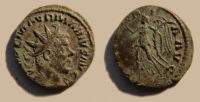 The British Museum seemed interested in acquiring the rarest of the coins — three coins struck under the rule of Marius who reigned for exactly 12 weeks in 269 A.D. — but that would have broken up the hoard. The St Barbe Museum and Art Gallery wanted to keep every coin and the pot together and put them on display a few miles away from where they were discovered and that was going to require some fast fundraising.
The British Museum seemed interested in acquiring the rarest of the coins — three coins struck under the rule of Marius who reigned for exactly 12 weeks in 269 A.D. — but that would have broken up the hoard. The St Barbe Museum and Art Gallery wanted to keep every coin and the pot together and put them on display a few miles away from where they were discovered and that was going to require some fast fundraising.
Rosalyn Goulding, of the museum, said the coins were an “exciting” find for the town.
“We haven’t had too much evidence of Roman activity here but this find helps us to build up a picture of settlement and agriculture,” she said.
“One of the coins is really interesting because it has an unrecorded reverse.
“The emperors would strike a series of coins and they each had a pattern to them – they would have similar things on the front and on the reverse – but this one had an altar on the back which has never before been seen on a Divus Victorious coin, or any coins issued by Victorious.”
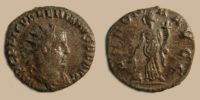 Historian and television presenter Dan Snow who lives in the area launched the fundraising campaign last fall with a target of £30,000 ($40,000). Donations large and small came from private individuals, local businesses, organizations and grants from charitable trusts. When the January 31st deadline arrived, the campaign was just short of its target at £27,842.20. One of the donors, American Anglophile Richard Beleson, bumped up his already generous donation of £7,500 in matching funds to cover the shortfall.
Historian and television presenter Dan Snow who lives in the area launched the fundraising campaign last fall with a target of £30,000 ($40,000). Donations large and small came from private individuals, local businesses, organizations and grants from charitable trusts. When the January 31st deadline arrived, the campaign was just short of its target at £27,842.20. One of the donors, American Anglophile Richard Beleson, bumped up his already generous donation of £7,500 in matching funds to cover the shortfall.
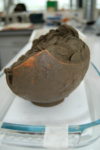 Most of that money was not needed for the acquisition of the hoard itself, which was modestly valued. It was to be spent on conservation of the hoard, necessary restoration of the space and to build a secure display case which will preserve the coins and pot in controlled conditions. The hoard’s needs fit seemlessly with the museum’s. A month before the fundraiser was launched, the St Barbe Museum and Art Gallery began an extensive refurbishment paid for by a £1.78 million grant from the Heritage Lottery Fund. The galleries were enlarged, the entrance improved and a new cafe was built. All together, this was a major upgrade for the small local museum, making it a fitting home for the Boldre Hoard and the extra eyeballs it is sure to draw. (Everybody loves a hoard, especially when it’s a local kid made good.)
Most of that money was not needed for the acquisition of the hoard itself, which was modestly valued. It was to be spent on conservation of the hoard, necessary restoration of the space and to build a secure display case which will preserve the coins and pot in controlled conditions. The hoard’s needs fit seemlessly with the museum’s. A month before the fundraiser was launched, the St Barbe Museum and Art Gallery began an extensive refurbishment paid for by a £1.78 million grant from the Heritage Lottery Fund. The galleries were enlarged, the entrance improved and a new cafe was built. All together, this was a major upgrade for the small local museum, making it a fitting home for the Boldre Hoard and the extra eyeballs it is sure to draw. (Everybody loves a hoard, especially when it’s a local kid made good.)
The refurbished museum had its grand reopening on Saturday with the Boldre Hoard as its centerpiece and signature treasure. Lord Montagu of Beaulieu did the honors, officially opening the inauguration day festivities.
